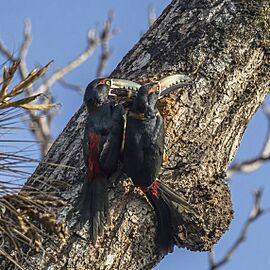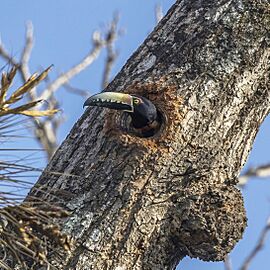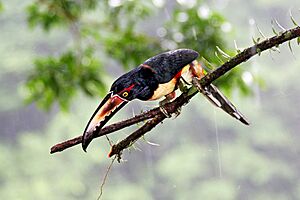Collared aracari facts for kids
Quick facts for kids Collared aracari |
|
|---|---|
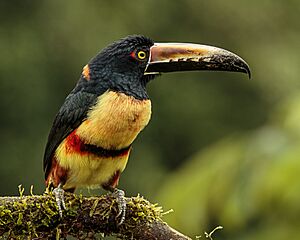 |
|
| P. t. torquatus, Costa Rica | |
| Conservation status | |
| Scientific classification | |
| Genus: |
Pteroglossus
|
| Species: |
torquatus
|
| Subspecies | |
|
See text |
|
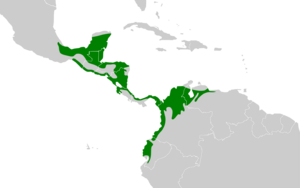 |
|
| Synonyms | |
|
|
The collared aracari (Pteroglossus torquatus) is a colorful bird that belongs to the toucan family. These birds are found in warm places from Mexico down to Colombia and Venezuela. They are known for their bright feathers and large, unique bills.
Contents
About the Collared Aracari
The collared aracari got its scientific name, Pteroglossus torquatus, from a scientist named Johann Friedrich Gmelin in 1788. The word torquatus is Latin and means "collared." This name describes the reddish collar you can see on the bird's neck.
Scientists recognize three main types, or subspecies, of the collared aracari:
- P. t. torquatus
- P. t. erythrozonus
- P. t. nuchalis
What Collared Aracaris Look Like
Like other toucans, collared aracaris are very colorful and have a big bill. Adults are about 38 to 41 cm (15 to 16 in) long. They weigh between 175 to 250 grams (6.2 to 8.8 oz). Both male and female birds have similar colors. However, the female's bill is shorter than the male's.
Their bill has a thin white line at its base. The top part of the bill is a buffy white color. It gets darker, turning reddish-brown, near its base. The tip and top edge of the bill are black. The bottom part of the bill is completely black.
Most of their upper body is glossy black. They have a narrow cinnamon-red collar on the back of their neck. Their lower back and rump are bright red. Their head, throat, and upper chest are a greenish-black. The lower chest, belly, and under the tail are yellow. The chest often has some red color and a black spot in the middle. A narrow red and black band crosses their upper belly.
Young collared aracaris look a bit different. They are duller than adults. Their head and chest are sooty-black, and their upper parts are brownish-olive. The red on their rump and the yellow on their belly are paler. The spot on their chest and the band on their belly are not as clear.
Subspecies Differences
The P. t. erythrozonus subspecies is smaller than the main type. It has a much smaller chest spot, or sometimes no spot at all. The P. t. nuchalis subspecies is similar to the main type. However, its chest spot is usually larger, and the white line at the base of its bill is wider.
Sounds and Calls
Collared aracaris make several different sounds. Their most common call is a high, sharp, squeaky sound. It can be described as "seek, pseek, pink" or "penk." They also make a two-part sound like "pi-cheet" or "squi-zeek." Sometimes, they make a soft "purr" sound. They also have an "aggressive, rasping grhhrr." When they fly, their wings make an audible whirring sound.
Where Collared Aracaris Live
Collared aracaris live in different areas depending on their subspecies:
- P. t. torquatus lives from central Mexico south through Central America into northwestern Colombia. It is not found on the Yucatán Peninsula.
- P. t. erythrozonus is found in southeastern Mexico, including the Yucatán Peninsula, Belize, and northern Guatemala.
- P. t. nuchalis lives in northern Colombia and northern Venezuela.
These birds live inside and at the edges of evergreen forests. They also live in coffee, cacao, and fruit farms. In drier areas, they can be found in forests along rivers. They live from sea level up to about 1,000 meters (3,300 ft) high.
How Collared Aracaris Behave
Social Life
Collared aracaris usually travel in groups of about six to 15 birds. Sometimes, other types of toucans join their groups. They also sleep together in tree cavities. Up to seven birds might share one hole overnight.
What They Eat
The collared aracari mainly eats fruit. But they also eat large insects, and the eggs and baby birds of other species. Sometimes, they eat other small animals. They usually look for food in the middle and top parts of the forest. However, they will also eat fruits found closer to the ground. They reach for fruit by stretching from a branch, bending, or even hanging upside down. They often spit out large fruit seeds, which can then grow into new plants.
Raising Their Young
Collared aracaris usually breed from January to May in most places they live. They make their nests in holes in trees. These holes are often made by large woodpeckers, or they might be natural holes. They can make the hole bigger if needed. Nests can be as high as 30 meters (98 ft) above the ground.
A female usually lays three eggs, but sometimes up to five. The eggs hatch after 16 to 17 days. Both parents take turns sitting on the eggs. The young birds leave the nest about 26 to 30 days after hatching. The parents, and often up to three other adult birds, help feed the baby birds. When they are very young, the babies are mostly fed insects.
Conservation Status
The IUCN (International Union for Conservation of Nature) says the collared aracari is a species of "Least Concern." This means they are not currently in danger of disappearing. They live across a very large area. However, their population size is not fully known, and it is thought to be decreasing.
There are no immediate major threats to these birds. But they are sensitive to deforestation, which is when forests are cut down. They are also sometimes hunted by local people.



